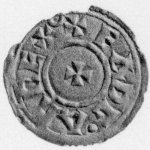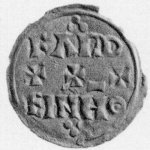
A royal official named Farthegn struck this coin one thousand years ago. Unlike many silver pennies minted during this period, this coin has no waves or cracks, indicating the great care that the moneyer took to let the coin cool down slowly. It was well-struck and well-centered. Farthegn made a fine coin.
Reverse side (image on the right): Reference guides show that the spelling "FERDEN" was a form of Faerthegn. The mint location is indicated by the word "DEOD". It's an abbreviated form of Thetford in Norfolk, England.
Obverse side (image on the left): This particular Farthegn was a moneyer for King Cnut, the first Scandinavian King of all England. The crowned bust of the king is looking to the left and is framed in a quatrefoil. The words "CNUT REX ANGLORV" are arranged around the outer edge.


The coin shown above was created by yet another moneyer named Farthegn (here spelled "Fardein"). Minted sometime between 959 A.D. and 972 A.D., it was minted somewhere within the Danelaw during the reign of King Eadgar. The reverse side of the coin, shown on the right, shows the moneyer's name in two lines separated by three crosses followed by "M--O". The obverse side, shown on the left, shows "+EADG'AR REX" arranged around the outer edge of the coin with a cross in the center.
Almost a hundred years had elapsed since the first Vikings had settled in England and they had begun to consider themselves to be more English than Scandinavian. However, there were still cultural differences between the residents of the Danelaw and "Saxon" England. Acknowledging this, King Eadgar went out of his way to make the Anglo-Scandinavians feel welcomed and many men of Scandinavian descent, such as Farthegn, became royal officials.